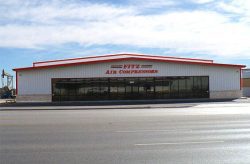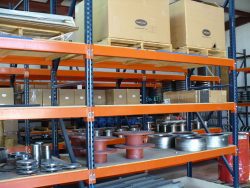How a Piston Type Compressor Works
Air compressors are essential workhorses across industries, from automotive to manufacturing. They come in various sizes and configurations, designed to meet commercial and industrial requirements.
In the air compressor market, piston types have been a longstanding choice. They use a crankshaft-driven piston to compress air, boosting pressure and potential energy.
In this blog, we cover how piston-type compressors work and how they help streamline various processes.
What Is a Piston-Type Compressor?
It’s important to know the two fundamental principles of compression to understand how piston compressors operate:
- Displacement: Air enters one or more compression chambers, which are then sealed off from the inlet. The volume within each chamber decreases due to moving one or more parts, leading to increased air pressure and internal air compression. A port or valve opens once the maximum pressure ratio is reached. The continued volume reduction in the compression chamber releases the compressed air into the outlet system.
- Dynamic: Unlike positive displacement compressors that operate with a steady flow, dynamic compressors maintain a constant pressure. Air is pulled through rapidly rotating blades, gaining high velocity. Then, air is expelled through a diffuser, converting its kinetic energy into static pressure.
The piston compressor is among the earliest and most widely used industrial air compressors. It employs the displacement principle and features a valve head, crankshaft, connecting rod and piston. These machines operate through the reciprocating motion of one or more pistons within a cylinder.
Piston compressors are known for their versatility and reliability. They help power pneumatic machinery, drive manufacturing processes and play a crucial role in refrigeration and air conditioning. However, they’re designed for intermittent use and operate only at about 50-60% of their duty cycle.
How Does It Work?
Piston-type compressors essentially involve a twofold process in which the pressure of air rises while the volume drops.
Step 1: Intake (Suction) Stroke
A piston compressor includes a cylinder with inlet and discharge valves at one end. These valves, shaped like metal flaps, are placed on opposite sides of the cylinder’s upper part.
The piston moves away from the cylinder head, creating a vacuum above it. Then, the intake valve opens, allowing air to fill the area above the piston.
While the inlet valves are open, the discharge valves remain closed, meaning air can enter but not exit.
Step 2: Compression Stroke
When the cylinder is full of air, the piston ascends, compressing air in a single stroke of pressure. In two-stage compressors, air enters a second cylinder for another round of compression.
Step 3: Power (Combustion) Stroke
Certain designs, like gas-powered piston compressors, involve a power or combustion stroke. During this phase, fuel is blended with the compressed air and ignited, supplying extra power to drive the piston.
Step 4: Discharge Stroke
Once the air is compressed to the desired pressure, the piston ascends, releasing the air through the open discharge valves. Compressed air can now be used to operate machinery linked to the unit’s supply lines. Most air compressors feature tanks that store air within defined pressure ranges for later use.
Piston-type compressors hinge on an ongoing intake, compression and discharge cycle, providing a constant source of compressed air for various applications
Advantages of Using Piston Compressors
Oil-Free and Oil-Lubricated Varieties
Depending on your specific needs, piston air compressors allow you to choose between models. They usually come in two types:
Oil-Injected Piston Compressors
Oil-injected piston compressors offer smoother operations and enhanced durability by lubricating cranks, pistons and cylinders. The lubricating oil contributes to efficient air compression and aids in heat dissipation.
The main drawback is the potential for residual oil to enter the compressed air. In industries with stringent air quality requirements, this can be a concern. Oil-lubricated piston-type compressors also require more maintenance, including regular oil changes.
Oil-Free Piston Compressors
Oil-free piston compressors have permanently lubricated bearings and grease-free piston rings. They’re ideal for industries where air purity is critical, such as electronics, food and beverage processing and pharmaceuticals.
In certain heavy-duty applications, oil-free compressors might experience higher wear and tear than oil-lubricated counterparts. The absence of lubricating oil can lead to higher operating temperatures, potentially impacting the system’s performance.
Simple Design
The main advantage of air power is that each instrument doesn’t require a bulky engine. Its straightforward design makes industrial air compressor maintenance a breeze. Spare parts are easy to find, ensuring minimal downtime.
Durability
A piston-type compressor is an excellent option for those seeking a dependable and durable machine. Although its lifespan varies based on brand, proper upkeep and frequency of use, most piston-type compressors last 10 to 15 years. This longevity makes it a valuable investment for any business.
High-Pressure Output
Piston compressors are ideal for applications demanding elevated compression ratios. These systems can be relied on from industrial to commercial settings for optimal performance and efficiency.
Cost Efficiency
Piston compressors have a lower upfront cost than other compressor types, rendering them suitable for smaller-scale operations.
Wide Range of Sizes
Piston-type compressors come in diverse sizes, ranging from portable devices to large stationary systems, providing tailored solutions for every application.
The Diverse Applications of Piston Compressors
Piston-type compressors serve as indispensable tools for numerous settings:
Automotive Industry
In vehicle repair shops and production facilities, piston compressors are used for tire inflation, painting and running pneumatic tools.
Food and Beverage Industry
Piston-type compressors assist in packaging, labeling and filling operations in food processing facilities. They provide clean and oil-free air essential for maintaining product quality.
Manufacturing Plants
These systems help keep manufacturing processes running smoothly by powering conveyor systems and operating automated machinery.
Construction Sector
Piston compressors power jackhammers, nail guns and concrete vibrators on construction sites, increasing efficiency and production.
Medical Applications
Piston compressors help power breathing equipment and other medical devices in healthcare facilities.
Refrigeration and Air Conditioning
Piston compressors are employed to compress refrigerant gasses, facilitating the cooling process.
Fitz Equipment: Your Go-to for Premium Air Compressors, Repairs and Maintenance
Explore a diverse range of reputable air compressor brands and types at Fitz Equipment. We are a Gardner Denver authorized distributor, offering brand-new and remanufactured units. Our skilled and friendly team specializes in industrial air compressor service, aiming to reduce downtime for you.
We take pride in our remanufacturing facility, recognized as the best in Texas and the surrounding states. Our team understands how downtime can impact any business. That’s why we go the extra mile to provide superior parts, competitive warranties and 24-hour on-call service wherever you are.
If you need guidance in selecting suitable industrial air compressors, get in touch with Fitz Equipment. As a family-owned business, we deliver top-notch customer service and ensure you receive the best system for your specific needs.




